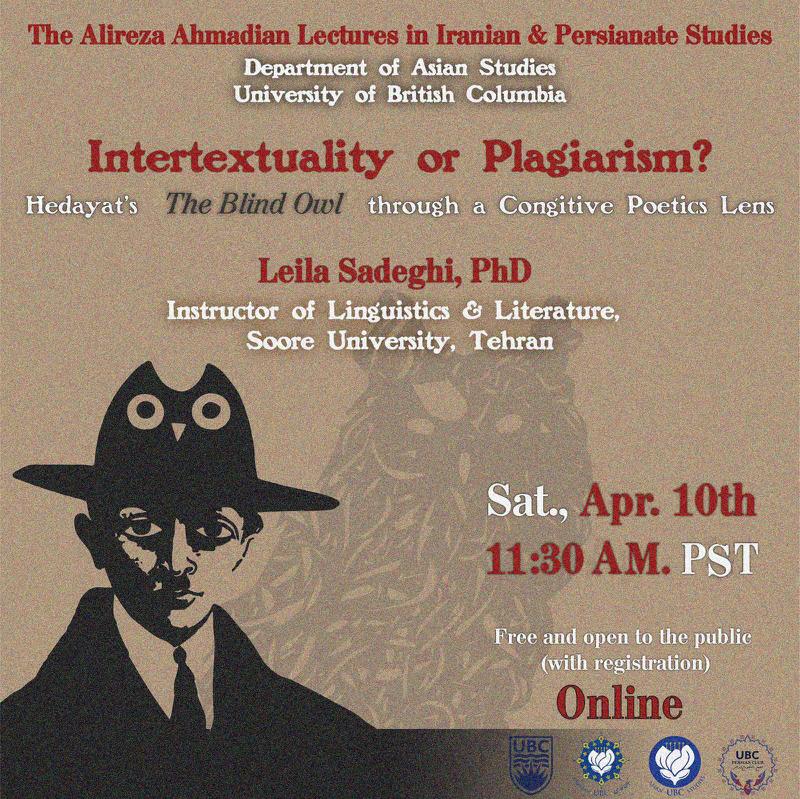



بینامتنیت یا سرقت ادبی؟ بوف کور صادق هدایت از منظرِ شعرشناسی شناختی
سخنران: دکتر لیلا صادقی، دکتری زبانشناسی دانشگاه تهران
بوف کور (۱۳۱۵) نوشتهٔ صادق هدایت، یکی از بحث برانگیزترین آثار برای تشخیص مرز باریک میان بینامتنیت و سرقت ادبی در سطوح متفاوت زبانی، ساختاری، مفهومی و غیره است. درواقع، براساس سه قاب بینامتنی معنایی، موضوعی و سبکی (پاناگیوتیدو، ۲۰۱۱) و همچنین سه نوع سرقت ادبی که نگارنده براساس سه سطح طرحوارهای مفهومی، متنی و زبانی (گای کوک، ۱۹۹۹) پیشنهاد میکند، امکان تمایز میان این دو اصطلاح، که هر یک نتیجهای کاملاً متفاوت به دست میدهند، فراهم میشود. با تعریفی ساده میتوان گفت که در سرقت ادبی، متن از پیشمتن فراتر نمیرود، اما در بینامتنیت متن به واسطهٔ گفتوگو با پیشمتنهای خود لایهلایه متکثر میشود و این گفتوگو به واسطهٔ تشخیص انواع قابهای بینامتنی میسر میشود، همان گونه که بوف کور در خلال تاریخ ادبیات داستانی همواره با تفسیرهای کاملاً متفاوت و گاه متقابل با یکدیگر مواجه بوده و این به دلیل ارتباط با پیشمتنهای مطرحی در ادبیات جهان از جمله هملت، اورلئا، دفترهای مالده لائوریس بریگه، دانشجوی پراگ، تار، ملوزین، مطب دکتر کالیگاری، نوسفراتو، نادیا، خشم و هیاهو، خون یک شاعر، موجها و بسیاری از دیگر آثار است. درنتیجه در صورت آشنایی مخاطب با هر یک از این پیشمتنها، قابی بینامتنی در ذهن او برای ایجاد تفسیری تازه شکل میگیرد.
براساس این تحقیق، تمایز سرقت ادبی با انواع بینامتنیت و به ویژه بینامتنیت سبکی درونهگیریشده یا غیرمستقیم، برمبنای دانش دایرةالمعارفی مخاطب امکانپذیر است که درصورت فعال شدن این دانش، پیشمتنهای موردمطالعهٔ مخاطب فراخوانده میشوند و میان پیشمتنها و متن ارتباطی ایجاد میشود که منجر به افزایش لایههای معنایی متن دوم میشود، همان گونه که نسبت بوف کور با دیگر آثار نسبتی تعاملی است و براساس سه سطح طرحوارهای کوک که در این بررسی نشان میدهم، این اثر از سطوح مختلف طرحوارهای هریک از پیشمتنها فراتر میرود، درنتیجه با ایجاد رابطهای تعاملی، در سطحی کلان جهان گفتمانی خود را به واسطهی پیوندهای بینامتنی گوناگون توسعه میدهد. از دستاوردهای این تحقیق در رویکرد شعرشناسی شناختی، ارائهٔ ابزاری نظاممند برای تمایز میان بینامتنیت و سرقت ادبی است که به باور پساساختگرایان امری ناممکن به نظر میرسد، اما در این تحقیق به امری قابلمطالعه و قابلاستفاده در زمینههای متفاوتی چون نقد ادبی، شکایتهای قضائی و پیگیری حقوق مؤلف تبدیل میشود.
The event recording is now available:
Presented in Persian with English subtitles.
Plagiarism is defined as “presenting someone else’s work or ideas as your own, with or without their consent, by incorporating it into your work without full acknowledgement.” It is, however, often mistaken for intertextuality, which is used to “designate the various relationships that a given text may have with other texts.” Despite their different goals, plagiarism and intertextuality are sometimes mistaken for each other due to their overlap in their drawing on others’ texts and the fact that they keep readers wandering between two worlds, i.e., that of the cited/copied text and that of the new one. Sadeq Hedayat’s The Blind Owl (1936) has often become the subject of a heated debate on the difference between intertextuality and plagiarism; indeed, The Blind Owl has been explicitly accused of plagiarism by some scholars who do not find a clear and practical border between plagiarism and intertextuality.
In this presentation, using The Blind Owl as a point of reference, and drawing on notions and theories in Cognitive Poetics, I will attempt to differentiate plagiarism from intertextuality, while also briefly pointing out the intertextual relations between The Blind Owl and a good number of other texts, including William Shakespeare’s Hamlet (1602); Gérard de Nerval’s Aurélia (1855); Rainer Maria Rilke’s Malte Laurids Brigge’s Notebooks (1910); Stellan Rye & Paul Wegener’s The Student of Prague (1913); Wyndham Lewis’s Tarr (1918); Franz Hellens’s Mélusine, Ou, La Robe De Saphir (1920); Robert Wiene’s The Cabinet of Dr. Caligari (1920); Friedrich Wilhelm Murnau’s Nosferatu (1922); André Breton’s Nadja (1928); William Faulkner’s The Sound and the Fury (1929); Jean Cocteau’s The Blood of a Poet (1930); Virginia Woolf’s The Waves (1931), etc. In its intertextual connections with these and other texts, The Blind Owl enters into a dialogue with them in order to project an innovative world—a world which would remain partly undiscovered were we not to familiarize ourselves with these intertexts.
Leila Sadeghi is an Iranian postmodernist poet and fiction writer. Holding a PhD in Linguistics from the University of Tehran, Sadeghi has published numerous articles on language and literature in Persian and English. She is an instructor of Linguistics & Literature at Soore University, Tehran.
Should you have any questions, please contact the Department of Asian Studies at Asian.Studies@ubc.ca.